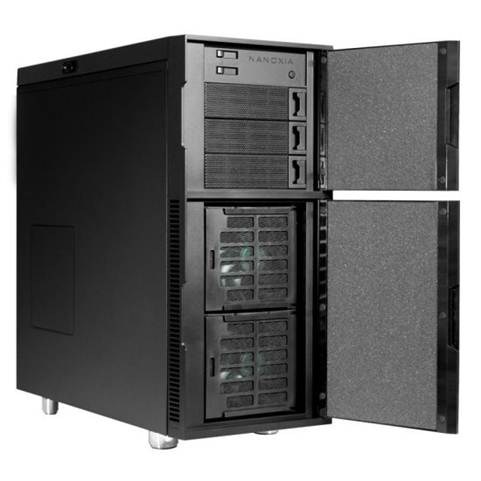Nanoxia takes on Fractal Design with
its low noise chassis
Making its first entry into the case
market, Nanoxia is a German firm better known for its modder friendly cables
and accessories. The Deep Silence 1 targets fans of quiet computing, and is
similar in price and design principles to Fractal Design's Define R4, featuring
noise dampening foam, fan blanking plates and a heavy steel chassis.

Nanoxia
Deep Silence 1
The DS1 is clad in black (other colours are
available) and has two 120mm intake fans and a 140mm exhaust fan (one more fan
by default than the R4). These are Nanoxia's own Deep Silence fans, with green
blades to match the power LED. Build quality all round is excellent the DS1 is
stable on its feet, the side panels are very rigid and there are no sharp edges
to speak of. A minor concern is the power button, which does feel quite wobbly.
The focus on noise reduction is apparent
everywhere you look. Noise absorbing foam lines the case doors and side panels,
and the empty side 120mm/140mm intake fan mount is blocked out by a blanking
plate (also covered in foam) when not in use, and has its own dust filter.
Elsewhere, hard drive mounts, the PSU area and the case feet are all equipped
with rubber to lessen vibrations.

Two magnetic front doors maintain the sleek
exterior of the DS1. Behind the top one are the three 5.25" drive bays
(one of which can be converted to a 3.5" bay), as well as the reset button
and dual channel fan control. Each channel can control up to three fans and
they have separate sliders to adjust the fan speeds. The lower door covers the
two intake fans, which are housed in their own push to open cages for easy
access, and also have slide out dust filters. A massive pull out filter along
the bottom ensures protection from dust there.
Along the roof is the embedded front panel,
complete with audio jacks, dual USB 2 ports and two USB 3 connections. Pushing
in on it opens it up for access, although this requires more force than it
should. What Nanoxia has termed an 'Air Chimney' is also found on the roof. A
slider lifts a section of the roof, supposedly allowing heat to escape
passively from the top, or actively if you take advantage of the two
120mm/140mm fan mounts beneath it.
A half-height dual radiator with fans can
also be fitted into the inner roof section, or you can fit a full-size double
radiator with fans behind the front panel, which would also benefit from
airflow from the two front intake fans. External setups can be accessed via
four water cooling holes on the rear, the grommets for which can be replaced by
ones that block them out entirely if you don't need them.
The upper five drive bays are split into
modular cages of two and three, which can be slid out along rails separately as
needed, whereas the lower three require a screwdriver to be removed. The
modular ones can be mounted further into the case, as shown, thanks to the
removable rails that cover the lower 120mm/140mm fan mount by default. This
gives users a great degree of flexibility regarding their hardware
configuration.
The tool free installation of optical
drives is simple and secure, but you'll need screws for both SSDs and regular
hard drives. That said, the rails you actually mount the drives to lock firmly
in place within the drive bays.

With your system built, cable routing is
next on the agenda, and Nanoxia provides plenty to help you on your way. Plenty
of sensibly placed holes with nice rubber grommets let you tuck cables into the
spacious area behind the motherboard tray. A extension cable for the EPS
connection, zip ties and hooks to attach them too all ensure a tidy system is
easy to achieve.
Cooling performance isn't great with the
DS1, but it's not awful either. The CPU and GPU temperatures don't quite match
those of the Fractal R4, but there's not too much between them. The noise
levels are outstanding however, with the foam and sealed design keeping the
total volume output to little more than a whisper.
The DS1 isn't the ultimate compromise
between noise and performance, but it's a great case nonetheless. The R4 is
slightly cheaper and offers better cooling and comparable noise levels, but the
DS1 is better built and has an extra fan alongside its superior fan control.
The front mount for radiators is also more secure than the R4's, and the
modular drive bays more versatile, and is thus well worth considering for a
quiet build.
|
Details
·
Price: $138
·
Manufacturer: Nanoxia
·
Website: www.nanoxia-world.com
·
Required Spec: ATX or micro-ATX motherboard
Verdict
·
Quality: 7
·
Value: 8
·
Overall: 7
|